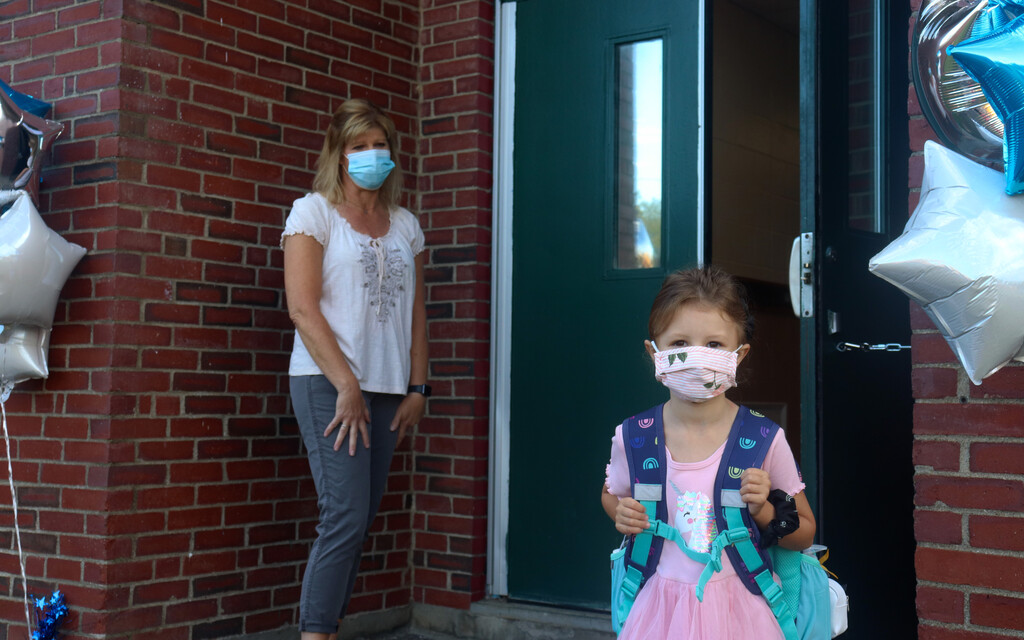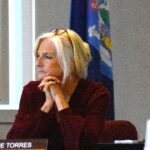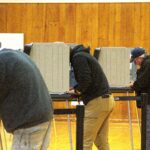
HOULTON, Maine — School is in session for all districts in southern Aroostook County, but what percentage of students are attending in-person classes?
A new option this school year, because of the COVID-19 pandemic, gave parents a choice between in-person instruction or remote learning for their children. Determining which method of education families would be doing was one of the top priorities for local superintendents this summer.

Houlton Elementary School staff member Jana White, left, gives directions to a student as he gets off the bus Thursday, Sept. 3, for the first day of school in RSU 29. (Joseph Cyr)
In RSU 29 (Houlton, Littleton, Monticello and Hammond), nearly 200 students have elected to do remote learning, according to Superintendent Ellen Halliday. That number represents about 16 percent of the district’s student population. There are 1,354 students enrolled in RSU 29 as of Sept. 3.
“While the pandemic situation remains uncertain, we recognize the need to explore alternatives to the traditional instructional model for the upcoming school year,” Halliday had previously said.
Last spring, all schools were faced with an emergency remote learning model that saw teachers reinforcing skills and concepts that students had already received. Halliday said remote learning this year will be vastly different, and more engaging for students.
“It is incumbent upon us to provide structured, timely, challenging learning opportunities while ensuring the highest level of safety for staff and students,” she said.

Danielle Fitzpatrick of Mill Pond Elementary School in Hodgdon directs traffic for parents dropping off their kids for the first day of school on Sept. 3, 2020. (Alexander MacDougall)
In SAD 70, a total of 87 students (17.4 percent) have opted for remote learning, according to Superintendent Stephen Fitzpatrick. Of that number, 51 are elementary students, while 36 are in middle-high school. There are about 500 students enrolled in SAD 70.
At Southern Aroostook Community School in Dyer Brook, with a student population of 330 students, RSU 50 Superintendent Jon Porter said his district has 44 students (13.3 percent of its student body) opting for remote learning this year. That number is broken down evenly with 21 students in grades kindergarten through fifth grade and 23 students in grades six-12.
“Instruction will be provided with a combination of synchronous — with a live camera in the classroom — and asynchronous [recorded lessons],” Porter said. “There will be an option for parents to switch their child to in-person or remote based on the student’s needs. We will meet with parents and children to discuss a transition plan prior to any change.”
RSU 89, Katahdin Elementary and Middle High Schools, has 20 percent of its population opting to learn remotely, according to Superintendent Marie Robinson.
At East Grand Community School in Danforth, SAD 14 Superintendent Margaret White said 14 percent of its student population has opted for remote learning, with 19 out of 137 total students choosing to remain home. The majority of those students (12) are enrolled in elementary school.
“Our remote students will be joining their classmates for live instruction,” White said. “Students can transition to in-person instruction at any time. We do ask families to only make one transition during the nine-week period.”

Houlton Elementary School staff member Brenda Robertson, right, watches over a student using a hand sanitizing machine outside of the school Thursday, Sept. 3, which marked the first day of classes for RSU 29. (Joseph Cyr)
East Grand School provides all of its students with electronic devices — laptops or tablets — to do their assignments. In addition, those families who may be without internet access are also given a wifi “hotspot” device.
“There are some areas that even a hotspot does not provide enough coverage for Zoom meetings,” White noted.
For those students attending in-person classes, East Grand has added nine outdoor structures to its campus and for as long as weather permits, many students will be taking advantage of those buildings.
“We will try to get a majority of our students outside for a large portion of the day,” White said. “We have boosted our outdoor internet connection, so when academic instruction is provided outdoors we will be able to have the remote learners join us.”







